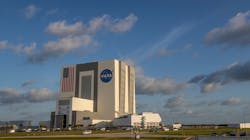NASA Gives OK for Thursday Rollout of Artemis I at Kennedy Space Center
NASA managers gave the OK to roll out the Artemis I rocket to the launch pad at Kennedy Space Center this Thursday for what it hopes is the last steps before a launch as early as May.
“Everybody at the Kennedy Space Center is really excited about where we’re at right now,” said Tom Whitmeyer, NASA’s associate administrator for exploration systems development. “The first of the rolling out of the [ Vehicle Assembly Building], that’s really an iconic moment to this vehicle and to be here for a new generation of a super heavy lift exploration class vehicle, Thursday is going to be a day to remember and we’re really excited about that.”
Any launch window can’t be nailed down until NASA runs through a wet dress rehearsal at Launch Pad 39-B. The 4.4-mile rollout of the 322-foot-tall rocket from the Vehicle Assembly Building will take about 11 hours. It’s slated to begin the journey at 5 p.m. Thursday, with weather looking good. Its top speed will be 0.8 mph.
NASA plans on live streaming the event.
Once at the site, the agency will need a month or more for testing and a rollback to the VAB before NASA signs off on a launch attempt for the uncrewed mission to the moon.
The next possible windows for launch are from May 7-21, June 6-16 and June 29-July 12.
The essential part of the test is the filling and draining of the core stage with 730,000 gallons of super-cooled liquid hydrogen and liquid oxygen while simulating a countdown but without lighting the engines. That tanking test is targeting April 3. A rollback could happen as early as eight or nine days after the test.
“We’ll wait and see what comes out of the wet dress and then that’s the point I think we’ll be in a good position as an agency to set a launch date,” Whitmeyer said. “It’s a couple weeks away, so we’re really getting close to be able to do that for you.”
Artemis I is the first of several planned missions to the moon. Using NASA’s Space Launch System rocket topped by the Orion crew capsule, Artemis flights look to return humans, including the first woman, to the lunar surface by 2025, the first return since the Apollo program ended in 1972.
Artemis I, though, is an uncrewed flight that will send Orion farther into space than any other human-rated spacecraft has ever traveled — 280,000 miles away, which is 40,000 miles beyond the moon. The SLS rocket will surpass the power of the Saturn V rockets of the Apollo program, producing 8.8 million pounds of thrust at liftoff.
The mission could last either four or six weeks when Orion returns to Earth for a splashdown in the Pacific Ocean near the coast of California.
Originally to have launched in 2016, the SLS and Orion hardware have seen numerous cost and production delays, which have had a domino effect on future Artemis missions.
NASA now plans the crewed Artemis II flight, which will take humans in an orbit around the moon without landing, no earlier than May 2024. The Artemis III mission, which would use a Human Landing System, currently contracted to SpaceX using a version of its Starship spacecraft, will bring two astronauts to the lunar surface. That mission is now planned for no earlier than 2025.
©2022 Orlando Sentinel. Visit orlandosentinel.com. Distributed by Tribune Content Agency, LLC.
